Art Fairs
viennacontemporary 2015 Dazzles with Top Quality Art and New Location
Will the re-branding pay off?
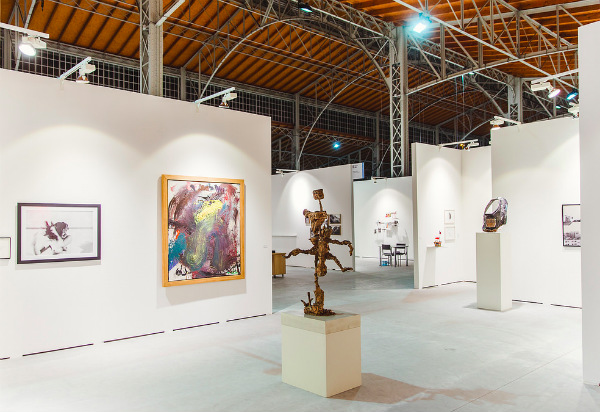
Photo: ©viennacontemporary : Aleksander Murashkin
Will the re-branding pay off?

Hili Perlson

The excitement was palpable at the preview opening of viennacontemporary, the newly-branded fair spearheaded by the impressive Christina Steinbrecher-Pfandt. The creative director and her team announced two major changes at the end of 2014, including a new venue, the historic Marx Halle, and a fixed date in September. After three years of operating under the brand Vienna Fair, which kept changing its fall dates, Steinbrecher-Pfandt opted for an important overhaul that will give viennacontemporary the opportunity to grow without having to compete with Frieze or FIAC for exhibitors and visitors.
“Was it comfortable to make this move?” Steinbrecher-Pfandt said, adding “Obviously, I had easier years. But if you want to be a professional international fair and not just a local player you have to make uneasy decisions,” she told artnet News.
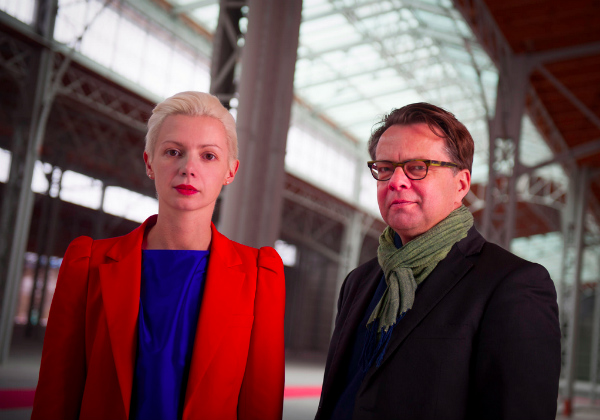
Directors Steinbrecher-Pfandt & Van den Heuvel
Photo: ©Henk Jan Kamerbeek
Yet matters took an unexpected turn earlier this year when the owner of the former brand name, Vienna Fair, sold the rights to a new operator, art fair veteran Wolfgang Pelz, who is staging his fair in October. “I don’t see any competition there” Steinbrecher Pfandt told artnet News. “I made a rational decision based on my experience of the last three years. I believe in what we do here; now we’re in and now we’re really playing!”
“We want to put Vienna on the map of the international art market and make it the center of an art dialog between East and West,” said Dmitry Aksenov, Russian real estate mogul and chairman of the board.
It may take several editions before viennacontemporary becomes an unmissable stop on the international art world’s calendar, but the rebranding is already proving to make a difference. With a strong focus on Central Eastern Europe (CEE), the fair is replete with museum quality works and historical positions from the Eastern Bloc and its unique strain of avant-garde. And indeed, museum groups from Germany, the UK, and the US were making the rounds during the preview.
But galleries are also voting with their feet for the new brand. European powerhouse Galerie Thaddaeus Ropac returned to Vienna after a year’s absence, showing a solo booth by Pakistani artist Imran Qureshi, who is new on the roster and currently has a solo show in the gallery’s Le Marais location in Paris. Works range from £12,000 for drawings, which Qureshi makes with imprints of his own body on paper, to £30,000-55,000 for the artist’s large scale paintings. “We wanted to return to the fair with the right artist to show,” the gallery told artnet News.
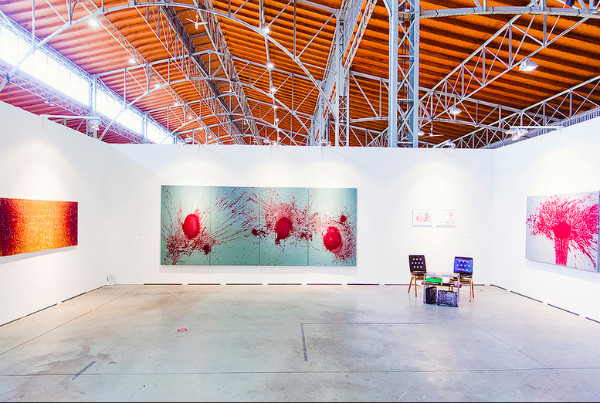
Galerie Thaddaeus Ropac
Photo: ©viennacontemporary : Aleksander Murashkin
Another returning exhibitor after a two-year hiatus was Galerie Martin Janda. “We had to prioritize before, and were showing at Frieze, but now we can do both,” said gallery director Elisabeth Konrath. The mixed booth included documentation of a performance by Roman Signer, carried out this year in Vienna, priced at €16,500 for an edition of 10, and rarely seen drawings by Signer from the 1970s, for €15,200 each.
As the stream of VIPs and collectors—such as Fondazione Prada’s Beatrice Boatto, Frederic de Goldschmidt, and Ranjan & Lekha Poddar—started pouring in, exhibitors were utterly positive about the fair’s revamp. “The new date was an absolute necessity” Judith Radlegger, of MAM Mario Mauroner Contemporary Art, told artnet News. “It was difficult to have a fair with dates that kept changing. And the new location is beautiful, it has a ‘Grand-Palais’ atmosphere,” she added. The Salzburg-based gallery is showing a mixed booth, with works by Jan Fabre going for €89,000 for small skulls made with jewel-beetle wing cases and taxidermy animals, and €245,000 for a large jewel-beetle work “painting.” Videoland (1987), a group of cone shaped metal sculptures with video monitors by Fabrizio Plessi, are priced at €165,000 for one or €330,000 for the lot of four.
With nearly 100 participating galleries, about a third of exhibitors were from CEE, and this year’s special guest was Bulgaria. Nevertheless, it was the Austrian galleries who really shined with excellent presentations.
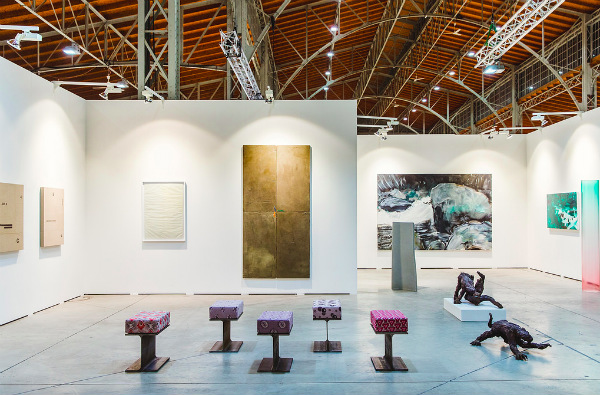
Nächst St. Stephan
Photo: ©viennacontemporary Aleksander Murashkin
Galerie nächst St. Stephan, whose owner Rosemarie Schwarzwälder was one of the initiators of the art fair, showed an expansive booth of well-established gallery artists. However, stealing the show was a group of sculptures by Sonia Leimer, a relatively new artist on the gallery roster. Leimer used USSR-era fabrics printed with patterns reflecting Soviet values and symbolizing physical labor, and steel parts used for construction, to create functional furniture-sculptures called I-Träger (2015). Three of the works, which go for €4,200 each, were already reserved on preview day.
Vienna-based Galerie Meyer-Kainer showed one of the strongest booths at the fair with works by Rachel Harrison, as well as renowned Austrian artists such as Heimo Zobernig, Gelatin, and newcomer Verena Dengler, who was featured in the New Museum’s 2015 Triennial and has a floor work at the fair, entitled Welcome to the continent (diddl) and priced at €9,000.
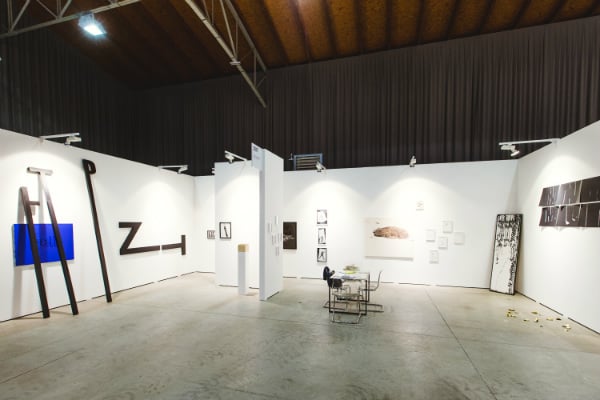
Unttld contemporary won an award for Best Austrian gallery presentation
photo: ©viennacontemporary Aleksander Murashkin
Gabriele Senn Galerie brought several text works on canvas by Michael Riedel from 2013 (€60,000-90,000 without VAT) and a more accessible older work from 2007, which responds to a show by Monica Bonvicini and includes a wallpaper and chains, priced at €160,000 before taxes.
Richard Saltoun Gallery staged a strong presentation of three leading figures of the feminist avant-garde—VALIE EXPORT, Jo Spence, and Renate Bertlmann—as a tribute to the groundbreaking show “Kunst mit Eigen-Sinn” that took place in Vienna three decades ago, in 1985. The timing is especially right for the presentation, as the city of Linz recently acquired the estate of VALIE EXPORT, and plans to open a center named after the artist.
That is not to say that younger names were underrepresented. Stefan Lundgren Gallery / Mallorca Landings showed wall-works and bronze sculptures by Luis Gispert (priced at €16,000) and wallpaper, C-prints, and video works by Jacolby Satterwhite (ranging from €8,000-16,000) which were drawing the attention of the fair’s video program curator Olaf Stüber.
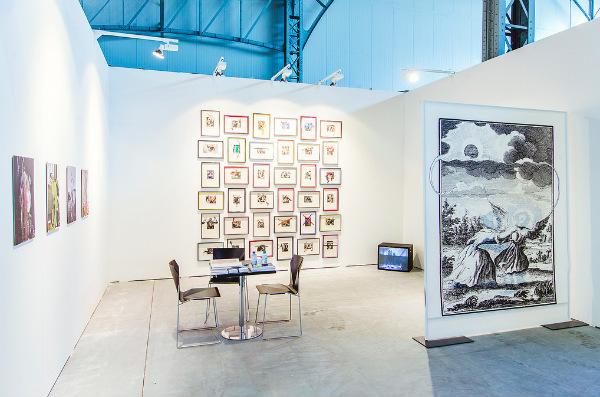
Gallery Martin Asbaek
Photo:©viennacontemporary Aleksander Murashkin
It was a particularly happy opening day for first-time exhibitor Martin Asbaek Gallery from Copenhagen, who won the fair’s International Gallery Prize for a solo presentation by Sofie Bird Møller, who works with images from old bibles, mysticism, and spell books, which she re-interprets into new confounding and mysterious imagery. A series of collages based on modified illustrations of Shakespeare texts was priced at €60,000.
Galerie Michael Schulz had the most expensive work at the fair: Gerhard Richter’s Fuji (1996) priced at €550,000. The gallery sold a work by Korean artist SEO titled Bergsee for €71,000.
With its first edition in the new location and under the new brand, viennacontemporary is staking its claim on the international scene with the best means possible: undeniable quality. It won’t take long before the art world starts paying closer attention.
viennacontemporary takes place at Vienna’s Marx Halle from September 24 – 27, 2015.
Related stories:
Swift Sales at Vienna Fair’s 10th Edition